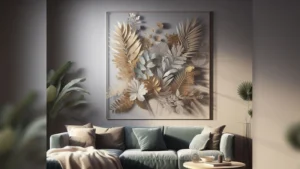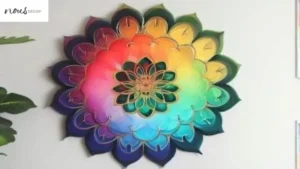As someone who has been Wall Art Collecting for over a decade, I’ve learned a lot about how to build a meaningful, visually appealing collection.
In this Nousdecor article, I’ll share my tips on the different types of wall art worth collecting, where to find unique pieces, how to properly hang and arrange your collection, and things to keep in mind as your assortment of art grows.
Key Takeaways of Wall Art Collecting
- Wall decor collecting can be an enjoyable and rewarding hobby that allows you to surround yourself with beautiful, meaningful pieces.
- When starting your collection, focus on purchasing art you genuinely love, mix different styles and mediums, and take your time finding special pieces.
- Proper hanging and arrangement is also key to creating an art collection you can treasure for years.
Types of Wall Art Worth Collecting
There are endless options when it comes to wall art. Here are some of my favorite genres and mediums to collect for enhancing spaces with unique wall art:
Traditional Fine Art
Paintings, prints, drawings, and sculptures have historically made up most art collections. When collecting traditional fine art, look for pieces that speak to you on an emotional level. I prefer works with bolder colors and visible brushstrokes.
Contemporary Art
Abstract art, pop art, and street art are more modern forms of visual expression that can add a stylish, current vibe to your home such as interactive mural installations for dynamic spaces. Consider collecting pieces in the signature style of your favorite contemporary artist.
Photography
Landscape photography, portraiture, and abstract photography are fantastic options for photo lovers. Black and white photography can have a particularly striking effect on your walls. Go for photos you find soothing or thought-provoking.
Textile Art
Add some texture with tapestries, quilts, or embroidery. Vintage or handmade textile art often has a wonderful story behind it. I love displaying my great aunt’s quilting above the bed in my guest room.
Mixed Media
Collage, assemblage, and installation art allow you to get more creative and dimensional with the wall art you collect for all the relationship between pop culture and wall art. Grouping a combination of mediums can result in a fascinating mixed-media installation.
Where to Buy Wall Art for Your Collection
When first starting your art collection, here are some places to browse for special pieces:
Art Galleries
Visiting local art galleries allows you to see works by talented local artists. Galleries are great spots to buy more high-end, original paintings and sculptures by established regional or national artists.
Online Stores
Online art stores give you access to an incredible selection of art from all over the world. They carry everything from prints and paintings to unique sculptures. Shopping online makes it easy to find art that matches your tastes.
Home Decor Stores
Check out the wall art selection at home decor stores like Target or IKEA for affordable options like framed prints, canvases, and posters. This can be a budget-friendly way to experiment with different styles.
Flea Markets & Antique Stores
For one-of-a-kind vintage finds, visit flea markets and antique stores. With some luck and persistence, you can start exploring unique wall art niches like retro signage or old landscape paintings.
Hanging and Arranging Your Wall Art Collection Ideas
To display your growing art collection properly:
Use Heavy-Duty Hangers
Invest in heavy-duty hooks and hangers made for picture frames. This prevents damage and allows you to securely hang even large, heavy paintings or mirrors.
Level Everything
Use a level to make sure every piece is aligned and straight on the wall. This gives your collection a polished, artful look.
Take Your Time
Don’t rush the hanging process. Play around with different arrangements and locations for each piece before firmly nailing or securing them in place.
Tips for Thoughtfully Collecting Wall Art
Here are some things I’ve learned about purposefully building an art collection you’ll love. Also, don’t forget to Care and Maintenance of Wall Art as well.
Set a Budget
Decide how much you can realistically spend on art each month. Setting a budget prevents overspending and helps you stick to pieces you truly adore.
Buy What You Love
When considering a new piece, forget about trends. Only buy art that you are drawn to and connects with your personal style.
Mix and Match
Don’t limit yourself to one particular art genre or time period. Mixing styles creates visual interest and reflects your eclectic tastes.
Take Your Time
Be patient and let your collection build slowly. With time, you’ll discover more unique pieces that speak to you. Don’t feel rushed.
Examples of Cohesive Gallery Wall Art Collections
To spark inspiration for your own curated collection, here are some examples of artfully designed wall art arrangements:
Modern Abstract Art
Group bright paintings, prints, and sculptures from contemporary abstract artists. This type of cohesive collection is perfect for minimalist spaces.
Vintage Travel Posters
Framed vintage posters from old travel agencies or transportation companies can easily create a chic, retro-themed wall gallery.
Family Photography
Fill your stairwell or hallway with custom-framed portraits or candid shots of your family. This adds a cozy, personal touch.
Botanical Prints
For plant lovers, frame a collection of 18th century botanical prints or pressed flower art for a natural, soothing look.
Children’s Artwork
Display your kids’ colorful masterpieces. Rotate in new pieces as they get older. This adds playful personality to any room.
Frequently Asked Questions
Conclusion
Building an inspiring wall art collection takes passion and patience. By sticking to pieces you genuinely adore, taking inspiration from curated galleries, and properly arranging your finds, you can create a custom art collection you’ll treasure for years to come.
Let your art reflect your personality and transform your space. Happy collecting!






